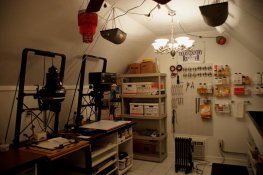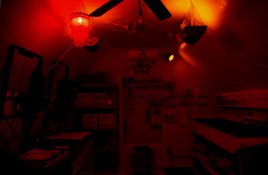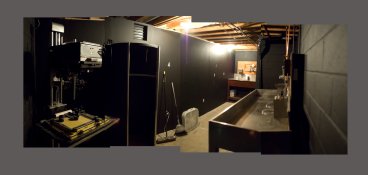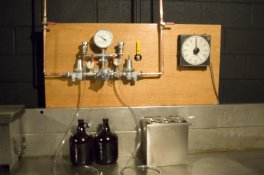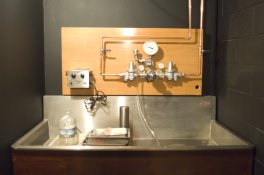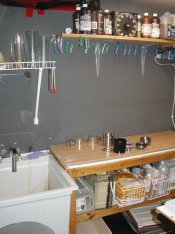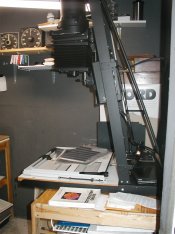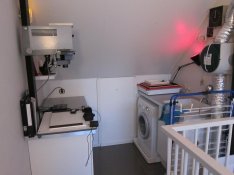My Minature Darkroom
My darkroom space measures 5.5' x 6' and fits into a corner of the utility room, across from the washer and dryer. In fact, we feed water from the same lines. The room isn't quite square; one corner is cut off to give more generous access to the washing machine, and that corner's where I fit the door. All of the materials for the darkroom were salvaged, except for the door hinges and door knob, and the drywall. Even the paint (a decent approximation of Zone V, actually!) was a reject from the paint store (the customer didn't like it so I got it for half price.) I figure I spent less than $100 for all the materials.
It's a little small, granted, but works fine for my needs. The wet sink is a laundry tub and the table next to it with the brown top is some sort of covered shelving; particle board covered with a tough plastic of some sort. I seal the edges with a couple of coats of marine polyurethane and every five years or so when the top gets too beat up I glue a new layer on top. Trays up to 11x14 fit well; 16x20 needs a tray ladder. I used to wash everything in trays in the tub but have been fortunate enough in the past couple of years to find an 8x10 washer at an auction and an 11x14 washer locally on Craigslist, and I made a washer for 4x5/5x7 film out of a plastic storage container and fishing line, so that part of processing is more convenient these days. The shelf under the table holds unopened chemicals, the 8x10 washer, etc. (the 11x14 washer is too large to store in the darkroom; it's in a garbage bag elsewhere in the basement. I bring it in to use it, of course!) Trays are on the floor underneath. Overhead are lines holding a number of plastic clothespins; this is overflow space to hang prints and film to dry. Primary space for drying is similar arrangement over the sink but it doesn't show in the picture. On the overhead shelf are mixed chemicals and a processing timer I just put up there today!
The enlarger is a Beseler 45 MX with condenser head. I have an older cold light which I bought on Ebay and used for a year; the lamp died and I hadn't fallen in love with it, so I went back to the condenser head. I got the enlarger for free from a local photographer, who got them for free from a local high school. He has two or three more he'd like to get rid of... (South Bend, IN.) That is actually my second 4x5 enlarger; years ago I got a Beseler 45 mcrx (or something like that) from another local school auction but it had many student years on it (I'm thinking dog years x 2,) and I'm glad to have had the opportunity to get a newer one in much better condition. Beyond the enlarger are a pair of 11x14 paper safes stacked on top of one another, and an old oak library card catalog holding 4x5 negatives on top of those. There's another small oak box on the very top, holding 5x7 negatives. Most negatives (35mm, 120 and 8x10) are stored in three-ring binders in bookshelves elsewhere in the basement.
Unopened paper is underneath the enlarger table, along with contact print frames, a semi-broken boom box (the radio part works, the CD player doesn't,) etc. Stored on the floor underneath are a paper cutter, currently empty chemical jugs, distilled water, etc. I recently discovered wire shelving at my local home improvement store, dirt cheap, and spent part of this weekend attaching them to the bottom of the shelf tops to give me more storage space. They work great! I also got a couple older Gralab timers at an auction and with the addition of the new shelving now have room to add them into the darkroom. Whoo-hoo, three processing timers; I feel like I've hit the big time!

Actually, one of the Gralab timers is earmarked for a UV light box I'm building so I can make cyanotypes, Van Dyke prints, and salt prints. It will be attached underneath the enlarger table, at the far end where the paper safes are on top. I have an older light box that was more a prototype to see if I was really interested in these other processes or not; it turns out that I am but the light box wasn't well thought out so I'll salvage the lights and ballast and make another out of the same white shelving material the wet side table top is made from. That way it won't take up precious table top space, which I am obviously short of!
This is the third darkroom I've had in my lifetime. The first was a corner of a detached garage used as an upholstery workshop during the day. The second was the loft over the workshop, light-proofed with aluminum foil and the heaviest sheet plastic the local home improvement store carried. Neither had running water and I carried water out in 5-gallon camping totes. In the summer it was so hot in the loft that the only practical means of working was in the nude and in the winter I shared part of the space with my oldest daughter's hampster (the workshop was heated, more or less, but not cooled.) In comparison, this one is pure luxury. I built it about seven or eight years ago, I think, and just recently have been upgrading it by adding more storage space. Better organization means that it's easier to clean, and for a darkroom that's really important so I'm doubly happy.
Mike








